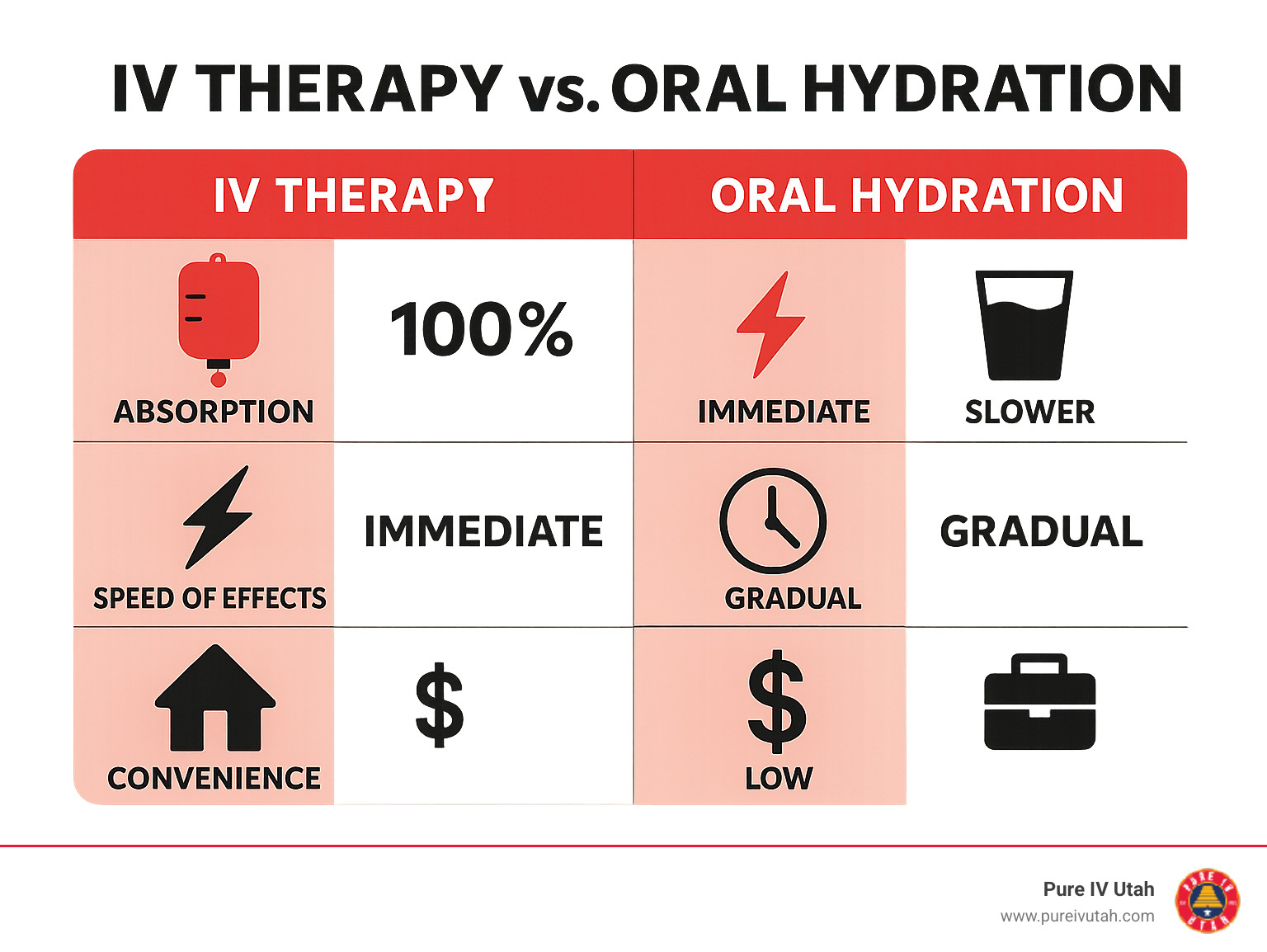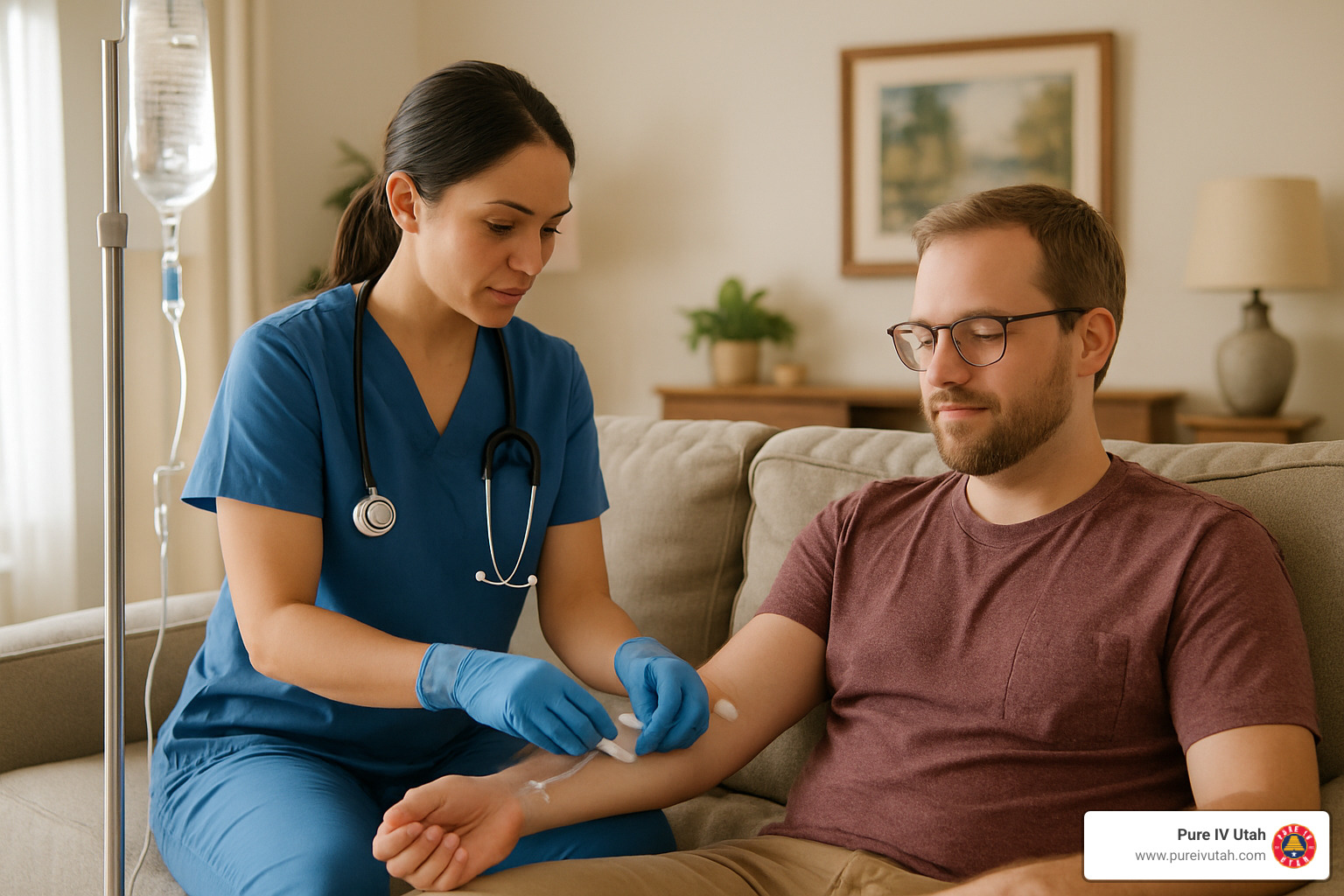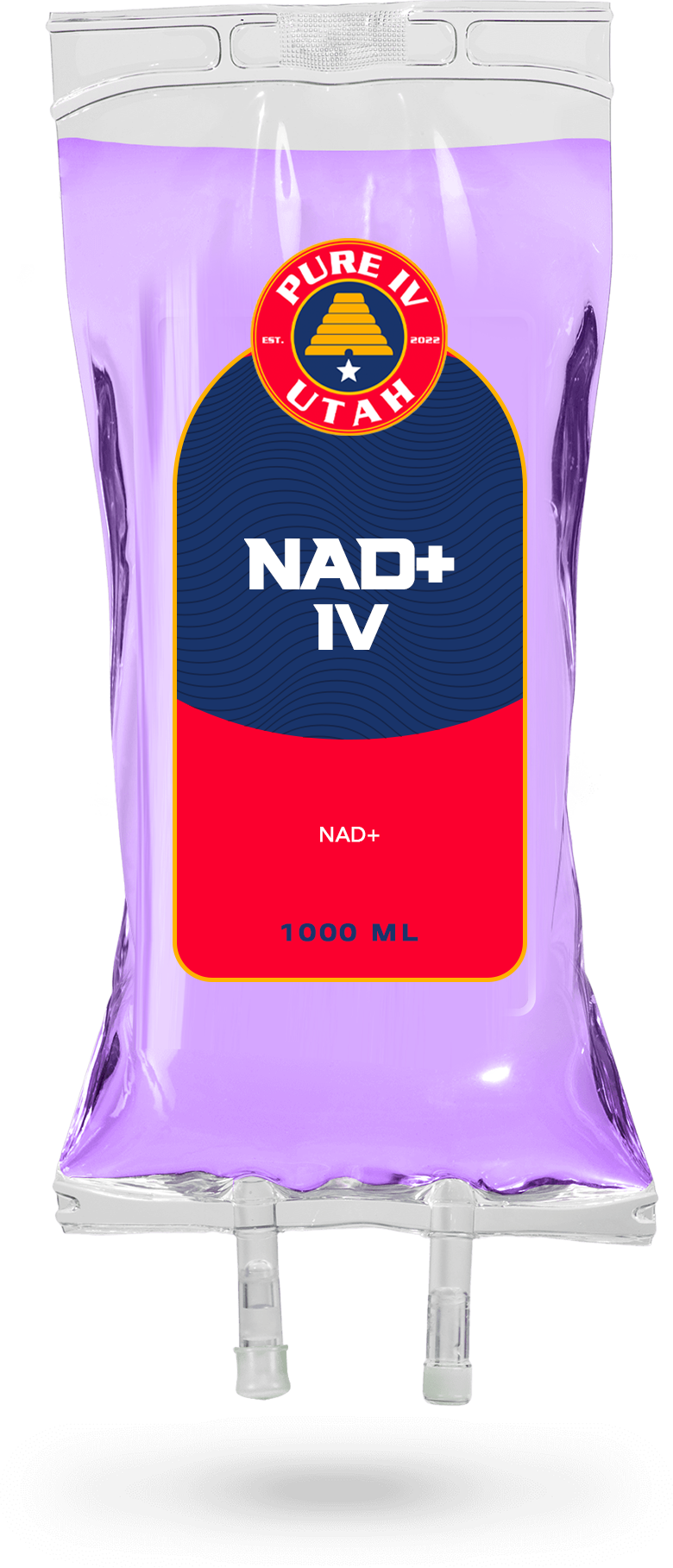A Practical Guide to Finding Home IV Service Providers

Medically reviewed by Micaela Strevay, FNP-C, PMHNP-BC
Joseph Lopez • June 17, 2025
Table of Contents
Why Home IV Service Is Changing Healthcare Delivery

Home IV service providers are revolutionizing how people receive hydration and nutrient therapy by bringing licensed medical professionals directly to your door. Instead of waiting in crowded clinics or emergency rooms, you can now get IV treatments in the comfort of your home, office, or hotel room.
Top home IV service providers offer: - Licensed nurses or paramedics who come to your location - Same-day appointments available 7 days a week - Custom IV formulas for hydration, hangovers, immunity, and wellness - Transparent pricing starting around $115-$435 per session - HSA/FSA payment options with detailed receipts - No travel fees within standard service areas
The mobile IV industry has exploded in recent years, with providers now serving major metropolitan areas across the United States. According to industry data, 90% of patients prefer receiving treatments at home rather than in medical facilities.
Home IV therapy sessions typically last 45-60 minutes and can address everything from dehydration and altitude sickness to hangover relief and immune support. While costs range from $199-$399 per session according to Harvard Health, many providers offer group discounts and membership programs to make treatments more affordable.
I'm Joseph Lopez from Pure IV Utah, and I've helped countless Utah residents access convenient, professional home IV service through our network of licensed medical professionals. As a mobile IV therapy provider, I've seen how home IV service eliminates the hassles of traditional healthcare while delivering personalized hydration and wellness solutions.

What Is Home IV Therapy & Who Benefits
Home IV therapy brings medical-grade hydration and nutrients straight to your bloodstream through a small IV line. Think of it as giving your body a direct highway to wellness, completely bypassing the usual traffic jam of your digestive system.
Here's what makes IV therapy so effective: when you drink water or swallow vitamins, your stomach and intestines have to break everything down first. Some nutrients get lost along the way, and others take hours to reach your bloodstream. With IV therapy, 100% of the fluids and nutrients go directly where your body needs them most - and you can actually feel the difference within minutes.
Your licensed nurse will customize your IV blend based on what you need. Saline or lactated Ringer's solution provides the hydration foundation, while B-complex vitamins give you natural energy without the coffee crash. For immune support, many people love high-dose vitamin C (up to 10,000mg - way more than you could ever absorb orally). Magnesium helps relax tense muscles, electrolytes restore cellular balance, and glutathione acts as your body's master antioxidant.
Athletes and weekend warriors are huge fans of home IV therapy. Whether you're training for a marathon or just pushed through an intense workout, the rapid absorption of electrolytes and amino acids can prevent those painful muscle cramps and cut your recovery time in half.
Travelers dealing with jet lag or altitude sickness find incredible relief through IV hydration. Your body needs extra fluids at high elevations, and when you're fighting altitude headaches in Park City or Moab, IV therapy can restore your energy and clear your head fast.
Let's be honest - hangover relief is probably what most people think of first. After a night out, alcohol leaves you severely dehydrated and depleted. The combination of fluids, electrolytes, and anti-nausea support can have you feeling human again within an hour instead of suffering all day.
People managing chronic illnesses often struggle to keep up with their hydration needs, especially when nausea or digestive issues make it hard to keep anything down. IV therapy ensures they get the essential vitamins and hydration their bodies need to function optimally.
Beauty enthusiasts love IV formulas packed with biotin, vitamin C, and glutathione for that glow-from-within effect. These nutrients support healthy skin, hair, and nails while fighting the cellular damage that leads to premature aging.
Busy professionals experiencing fatigue can quickly recharge with B-vitamins and proper hydration. When you're constantly running on empty, even mild dehydration can cause brain fog and headaches that make everything feel harder than it should be.

Evaluating and Booking a Home IV Service
Choosing the right home IV service provider doesn't have to be overwhelming, but it does require some homework. Think of it like hiring any healthcare professional - you want someone qualified, trustworthy, and transparent about their services.
Start with the basics: geographic coverage. There's no point falling in love with a provider who doesn't serve your area. Here in Utah, we at Pure IV Utah cover Salt Lake County, Utah County, Davis County, Weber County, Washington County, and Tooele County. That includes everywhere from busy Salt Lake City to scenic Park City and sunny St. George.
Credentials matter more than fancy websites. You want registered nurses (RNs), nurse practitioners (NPs), or paramedics with real medical backgrounds. Look for professionals with experience in emergency medicine, critical care, or specialty infusion therapy. Don't be shy about asking about their training - legitimate providers are proud to share their qualifications.
Transparent pricing is a green flag. If a company won't tell you upfront what treatments cost, that's a red flag. Quality providers clearly display their base packages, which typically start around $115 for basic hydration and can reach $435 for comprehensive wellness formulas. Premium add-ons like NAD+ therapy might cost $100-$999, but you should know this before booking.
Customization options show that a provider understands everyone's needs are different. The best services let you add extras like glutathione shots or specific vitamin boosters to tailor your treatment.
Operating hours and availability can make or break your experience. Look for providers who operate seven days a week with extended hours - typically 8 AM to 8 PM - and can accommodate same-day appointments when you need them most.
Booking a Home IV Service Step-by-Step
The booking process should be as smooth as ordering your favorite takeout. Here's how it typically works with quality home IV service providers:
First, browse the treatment menu and pick what sounds right for your needs. Whether you're dealing with a hangover, prepping for a big athletic event, or just want to boost your immune system, there's usually a package designed for your situation.
Next, hop online to schedule through the provider's website or app. Most systems let you pick your preferred date, time, and location in just a few minutes. No need to wait on hold or play phone tag.
Then comes the health questionnaire - don't skip this part! It covers your medical history, current medications, and what you're hoping to achieve. Some providers include a quick telehealth chat with a nurse practitioner to make sure your treatment is perfectly customized.
Payment setup is usually straightforward. Most providers accept HSA/FSA accounts (bonus points for tax savings!), plus credit cards, debit cards, and cash. You'll get detailed receipts that make insurance reimbursement attempts much easier.
Finally, prep for your appointment by making sure someone over 18 will be present and having a comfortable spot ready for your 45-60 minute treatment. Stay hydrated beforehand - it actually makes the whole process easier.
The best part? Quality providers don't charge travel fees within their standard service areas, and many offer group discounts if you're booking with friends or family.
What to Expect During a Home IV Service Visit
Your home IV service visit should feel professional yet relaxed - like having a skilled nurse friend stop by to help you feel better.
When your nurse arrives, they'll come equipped with medical-grade supplies in sterile packaging. The first few minutes involve reviewing your health information, checking your vital signs (blood pressure, pulse, temperature), and discussing any last-minute questions or concerns.
The sterile setup happens right in front of you using proper medical technique. Everything - IV catheters, tubing, solutions - is single-use and opened fresh. It's actually pretty reassuring to watch a professional work.
Getting the IV started usually happens in your arm using a small catheter. Experienced nurses make this quick and relatively painless, though you might feel a brief pinch. If you're squeamish about needles, just look away and chat about something else.
During the 45-60 minute infusion, you're free to relax however you want. Read a book, catch up on Netflix, scroll your phone, or even work if you need to. Many people start feeling the effects within 15-30 minutes as the hydration and nutrients hit their bloodstream.
Here are some comfort tips that make the experience even better: eat a light meal beforehand to prevent any lightheadedness, wear loose-fitting clothes for easy arm access, grab a blanket since IV fluids can make you feel cool, and speak up immediately if anything feels uncomfortable.
Before leaving, your nurse will monitor you for any reactions, give you aftercare instructions, and make sure you're feeling stable. Most people can jump right back into their normal activities - often feeling better than they have in weeks.
Key Safety Standards & Qualifications
Safety isn't negotiable when it comes to home IV service. You're letting someone put medical equipment in your body, so they better know what they're doing.
Every nurse should hold a current state license - no exceptions. Many of the best providers have backgrounds in emergency medicine, critical care, or specialized infusion therapy. Don't hesitate to ask about their specific training and experience.
Medical supervision matters too. Reputable providers work under physician oversight with clear protocols for different treatments and emergency situations. This isn't a freelance operation - there should be real medical backing.
Infection control protocols need to be hospital-grade. That means single-use sterile equipment, proper hand hygiene, aseptic technique, and appropriate disposal of medical waste. If anything looks sketchy, speak up.
Malpractice insurance protects everyone involved. Legitimate services carry comprehensive professional liability coverage because they take their responsibility seriously.
Emergency preparedness should include clear protocols for adverse reactions, immediate access to emergency medical services, and established escalation procedures. Your nurse should know exactly what to do if something goes wrong.
While complications like infection and superficial thrombophlebitis are possible with any IV therapy, the risks are minimal when proper protocols are followed by trained professionals.
Questions to Ask Before Hiring
Before booking any home IV service, arm yourself with these important questions. A good provider will answer them happily and thoroughly.
Ask about ingredient sourcing: "Where do you get your IV solutions and medications? Are they FDA-approved and pharmacy-grade?" You want to know exactly what's going into your body.
Discuss emergency protocols: "What happens if I have a bad reaction? Do you carry emergency medications and have direct contact with a physician?" This isn't being paranoid - it's being smart.
Clarify age policies: "Do you treat patients under 18? What are your age restrictions and parental consent requirements?" Important if you're considering treatment for teens.
Check after-hours support: "Can I reach someone if I have concerns after my treatment? Do you offer 24/7 support?" Peace of mind is worth a lot.
Understand cancellation terms: "What's your cancellation policy? Do you require 24-hour notice?" Life happens, and you want to know your options.
Explore customization: "Can treatments be modified during the visit? What add-ins are available?" Flexibility shows they care about your individual needs.
Get billing details: "Do you provide detailed receipts for insurance or HSA reimbursement? What payment methods do you accept?" Money talk might be awkward, but it's necessary.
Pricing, Insurance & Scientific Evidence
Let's talk money and science - the two things everyone wants to know about before booking a home IV service .
The price range for home IV therapy might surprise you. While some basic hydration packages start around $115, most quality treatments fall between $199-$399 per session. Think of it like this: you're paying for a licensed nurse to come to your home with medical-grade equipment and custom-formulated solutions. That's quite a bit different from grabbing a sports drink at the gas station.
Premium treatments can get pricey fast. NAD+ therapy, which some people swear by for anti-aging benefits, can cost anywhere from $100 to $999 depending on the dosage. Add-ins like glutathione shots ($40), vitamin boosters ($25-$50), or extra saline ($50) can bump up your bill quickly.
Many providers offer membership programs that can save you 10-34% per session. These typically involve monthly fees around $199 for treatment credits. If you're planning to use IV therapy regularly, the math often works out in your favor.
Here's the reality about insurance coverage : most plans won't pay for elective IV therapy. Insurance companies classify it as wellness rather than medical treatment. The good news? Most providers accept HSA and FSA accounts , and they'll give you detailed receipts if you want to try for reimbursement.
The scientific evidence is where things get interesting - and a bit complicated. IV therapy is absolutely proven for treating serious dehydration and nutrient deficiencies in medical settings. But many of the wellness claims you see advertised? The research is still catching up.
Hangover relief, jet lag recovery, and beauty benefits don't have the robust clinical trials you'd find for, say, heart medications. That doesn't mean they don't work - many people swear by the results. It just means we need more research to understand exactly how and why.
The risks are real but small when proper protocols are followed. Infection and thrombophlebitis (vein inflammation) are possible, though rare with experienced providers. Harvard Health points out that for most healthy people, good old-fashioned water and oral supplements work just fine for typical wellness needs.
| Package Tier | Price Range | Typical Contents | Best For |
|---|---|---|---|
| Basic Hydration | $115-$150 | Saline, electrolytes | Mild dehydration |
| Standard Wellness | $200-$250 | B vitamins, vitamin C, magnesium | General wellness |
| Premium Recovery | $300-$350 | Full vitamin complex, glutathione, amino acids | Athletic recovery, hangovers |
| Specialty (NAD+) | $600-$999 | Anti-aging compounds, high-dose nutrients | Longevity, chronic fatigue |
Stretching Your Budget
Nobody likes overpaying for healthcare, so here are some smart ways to make home IV service more affordable.
Membership programs are usually your best bet if you plan to use IV therapy more than once or twice a year. The monthly credits often reduce your per-session costs by 20-34%, which adds up quickly.
Referral programs can put money back in your pocket. Many providers offer $25-$50 credits when you successfully refer friends or family members. It's a win-win situation.
Group sessions are perfect for parties, team events, or just splitting costs with friends. When multiple people book treatments at the same location, most providers offer group discounts.
Timing matters for your wallet. Off-peak booking during weekdays or non-holiday periods often comes with lower rates. Weekend and holiday surcharges are pretty common in this industry.
HSA and FSA accounts are like getting a discount equal to your tax rate. Since you're using pre-tax dollars, a $200 treatment might only cost you $150-$170 out of your actual take-home pay.
Comparing Home IV vs Oral Hydration
The million-dollar question: is home IV service really worth it compared to just drinking water and taking vitamins?
The absorption difference is dramatic. IV therapy delivers 100% of nutrients directly into your bloodstream, while oral supplements lose some effectiveness as they travel through your digestive system. Your body has to work to break down and absorb pills and liquids, and some nutrients just don't make it through.
Speed is where IV therapy shines. You'll feel effects within minutes, compared to 30-60 minutes for oral hydration. When you're dealing with a crushing hangover or severe dehydration, those extra minutes matter.
But let's talk about cost reality. Oral hydration costs pennies per serving. A quality electrolyte drink might cost $2-$3. An IV session costs $100-$400+. That's a significant difference that adds up over time.
Convenience is complicated. Yes, having a nurse come to your home eliminates travel time. But you still need to schedule appointments, wait for availability, and block out 45-60 minutes for the treatment. Oral hydration is available 24/7 from your kitchen tap.
IV therapy works best when you need rapid results, have absorption issues, or want maximum bioavailability of nutrients. Oral hydration works best for daily maintenance, budget-conscious wellness, and situations where you don't need immediate effects.
The honest truth? For most everyday wellness needs, proper oral hydration combined with a balanced diet does the job just fine. IV therapy becomes valuable when you need faster results, have specific absorption challenges, or want the convenience of professional care at home.

Frequently Asked Questions about Home IV Service
Let's tackle the most common questions people have about home IV service . These are the real concerns I hear from Utah residents every day, and I want to give you straight answers.
Is a home IV service safe for healthy adults?
Yes, home IV service is safe for healthy adults when you choose a provider that follows proper medical protocols. The key word here is "proper" - not all providers are created equal.
Here's what makes it safe: licensed nurses conduct health screenings before your appointment through detailed questionnaires. Some providers also do quick telehealth consultations to spot any red flags that might make IV therapy unsuitable for you.
During your treatment , safety measures include checking your vital signs before starting, using completely sterile single-use equipment, and monitoring you throughout the entire process. Your nurse stays with you the whole time and knows exactly what to do if anything feels off.
Side effects are usually minor - maybe some temporary soreness where the IV goes in, feeling a bit chilly during the infusion, or very rarely, an allergic reaction to one of the ingredients. That's why having a licensed professional there matters so much.
The bottom line? When done right by qualified professionals, it's as safe as getting an IV at your doctor's office or hospital.
How long does a home IV service take from booking to finish?
One of the best things about home IV service is how quick and easy the whole process is. I'm talking surprisingly fast.
Booking takes about 5-10 minutes through most providers' websites or apps. The systems are designed to be user-friendly - no complicated forms or confusing options.
Many providers offer same-day appointments , especially if you're booking during weekdays or outside peak times like Friday evenings and weekends. Sometimes you can literally book in the morning and have a nurse at your door that afternoon.
The actual IV treatment takes 45-60 minutes once your nurse gets everything set up. Add another 15-20 minutes for the initial consultation, equipment setup, and post-treatment check, and you're looking at about 60-90 minutes total from when your nurse arrives to when they leave.
Most services operate 7 days a week from 8 AM to 8 PM, with some offering extended hours. This flexibility means you can fit treatment into your schedule instead of rearranging your whole day around a clinic appointment.
Will my insurance pay for a home IV service?
This is probably the question I get asked most, and I wish I had better news. Insurance coverage for home IV service is extremely limited because most treatments fall under "wellness" rather than "medical necessity."
Here's the reality : most providers, including us at Pure IV Utah, are "private pay" services. You'll be paying out of pocket for your treatments.
But there are some bright spots. HSA and FSA accounts often accept IV therapy expenses when you have proper receipts. We provide detailed documentation that works well for these pre-tax health accounts.
Some people try submitting claims to their insurance for reimbursement, especially if they're using IV therapy for a medical condition rather than general wellness. Success rates are low, but the detailed receipts we provide give you the best shot if you want to try.
A few tips for managing costs : budget for out-of-pocket expenses, use your HSA or FSA funds when possible, and ask about membership programs if you plan to use the service regularly. Some providers offer payment plans or financing options too.
The lack of insurance coverage is frustrating, but many people find the convenience and effectiveness worth the investment in their health and well-being.

Conclusion
Choosing a home IV service doesn't have to be overwhelming. The industry has grown up quite a bit, and you can now get genuine hospital-quality care delivered right to your couch. Pretty amazing when you think about it.
Your takeaway checklist:
Safety first - this one's non-negotiable. Make sure your provider uses licensed RNs or paramedics with real credentials, follows sterile protocols like they would in a hospital, and carries malpractice insurance. Don't compromise here.
Compare costs honestly - understand that base pricing runs $115-$435 , factor in add-on fees, look into membership benefits if you'll use the service regularly, and remember that HSA/FSA acceptance can help with the financial sting.
Set realistic expectations - IV therapy is genuinely excellent at rapid hydration and getting nutrients into your system fast. But it's not a fountain of youth or a miracle cure. Many wellness claims sound great but lack solid scientific backing.
Consider your alternatives - for basic hydration needs, drinking water still works wonderfully and costs pennies. Save home IV service for times when you really need rapid intervention or when keeping fluids down is a challenge.
Check geographic accessibility - make sure your provider actually serves your area without charging you extra travel fees that eat into your budget.
For Utah residents, we at Pure IV Utah understand that life gets busy and sometimes you need professional help getting back on track. We bring licensed medical professionals directly to your location across Salt Lake County, Utah County, Davis County, Weber County, Washington County, and Tooele County. Our pricing is transparent, our nursing staff has real experience, and we're committed to doing things safely.
Whether you're dealing with altitude sickness up in Park City, need hangover relief after a night out in Salt Lake City, or want immune support down in St. George, professional home IV service can provide rapid, effective treatment without the hassle of sitting in waiting rooms or dealing with clinic schedules.
The bottom line is simple: choose providers who put safety first, tell you exactly what things cost upfront, and employ qualified medical professionals who know what they're doing. With proper research and realistic expectations, home IV service can become a valuable tool in your wellness toolkit.




